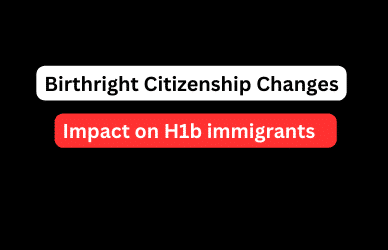Transferring an H1B visa to a new employer can be a complex process, but with the right information and preparation, it can be managed smoothly. This guide will walk you through the H1B visa transfer process, including timelines, costs, processing times, considerations after a layoff, and frequently asked questions (FAQs).
Understanding the H1B Visa Transfer Process
The H1B visa transfer allows foreign workers in the United States to change employers without leaving the country. This process, also known as H1B portability, is simplified by the American Competitiveness in the 21st Century Act (AC21), allowing H1B holders to start working for a new employer as soon as the petition is filed, provided certain requirements are met.
Initiating the H1B Transfer
- Job Offer: The first step is to receive a job offer from a U.S. employer willing to sponsor your H1B visa.
- Labor Condition Application (LCA): The new employer must file an LCA with the U.S. Department of Labor (DOL). This application ensures that the employer will pay the prevailing wage for the position in the geographic area where the job is located.
- Form I-129 Petition: Once the LCA is approved, the employer will file a new H1B petition (Form I-129) with U.S. Citizenship and Immigration Services (USCIS). This petition is for transferring the H1B visa from the old employer to the new one.
H1B Visa Transfer Timeline
The timeline for an H1B visa transfer can vary. Generally, the processing time for regular processing is between 1 and 5 months, while premium processing can take between 15 to 30 days. Here is a step-by-step breakdown:
- Job Offer and Acceptance: This can take a few weeks to a few months, depending on the job search and interview process.
- LCA Approval: This typically takes about 7 to 10 days.
- Filing Form I-129: Once the LCA is approved, the employer can file Form I-129. The processing time for this can vary based on whether regular or premium processing is chosen.
H1B Visa Transfer Cost
The cost of an H1B transfer involves several fees, which are usually borne by the sponsoring employer. These can include:
- Base Filing Fee: $460 for Form I-129.
- ACWIA Fee: $750 for employers with 1-25 full-time employees or $1,500 for employers with 26 or more employees.
- Fraud Prevention and Detection Fee: $500.
- Public Law 114-113 Fee: $4,000 for employers with 50 or more employees, where more than 50% are in H1B or L-1 status.
- Premium Processing Fee: $2,805 for expedited processing.
H1B Transfer After Layoff
If you are laid off while on an H1B visa, you have a 60-day grace period to find a new employer willing to sponsor your visa. During this period, you can stay in the U.S. but cannot work until the new employer files an H1B transfer petition. Here are some key points to consider:
- Job Search: Start your job search immediately to maximize your chances of finding a new position within the 60-day window.
- Negotiating Severance: If possible, negotiate a severance package that extends your financial stability during the job search.
- Legal Assistance: Consulting with an immigration attorney can provide clarity and help navigate the transfer process smoothly.
H1B Transfer Processing Time
The processing time for an H1B transfer can vary based on several factors, including the USCIS service center handling the petition and whether premium processing is used. Here is a general overview:
- Regular Processing: 1 to 5 months.
- Premium Processing: 15 to 30 days.
Required Documentation for H1B Transfer
To initiate the H1B transfer process, the following documents are typically required:
- Current Visa Status: Valid passport, visa, or I-94 record.
- Educational Documents: Transcripts and diploma.
- Work Experience: Evidence of relevant work experience.
- Employment Contract: Signed employment contract with the new employer.
- Previous H1B Approvals: Copies of prior H1B approval notices.
Potential Challenges and Best Practices
Navigating the H1B visa transfer process can be challenging, but careful preparation can help mitigate potential issues. Here are some best practices:
- Stay Informed: Keep up-to-date with the latest immigration laws and procedures.
- Legal Assistance: Hire an experienced immigration attorney to guide you through the process.
- Timely Documentation: Ensure all documentation is accurate, complete, and submitted on time.
- Effective Communication: Maintain open lines of communication with your new employer and legal counsel to address any concerns promptly.
H1B Transfer FAQs
Q: Can a person with an H1B visa transfer/change jobs?
A: Yes. The new employer must file an H1B visa petition[4].
Q: Before I apply for an H1B transfer with my new employer, do I have to inform my current employer?
A: No, you don’t have to inform your current employer, and there is no way for them to know about the transfer from any government agency. You don’t need permission from your current employer for an H1B transfer[4].
Q: Is there any limit to how many times I can apply for an H1B transfer?
A: No. You can apply as many times as you want[4].
Q: Can I apply for an H1B transfer for multiple employers at the same time?
A: Yes, you can apply for multiple H1B transfers simultaneously[4].
Q: Do I need to get an H1B visa stamped in my passport for my new employer?
A: No, the H1B visa stamp is used only to enter the United States. If you have received H1B approval for the new employer, you can work in the U.S. on H1B status for the new employer without needing a new stamp[4].
Q: Can I transfer my H1B before October 1 to a new employer?
A: Yes, you can transfer your H1B before October 1 if you have a valid H1B visa[4].
Q: What happens if my H1B transfer is denied?
A: If your H1B transfer is denied, you may need to stop working for the new employer and take corrective actions based on the reasons for denial[1].
Q: Can I travel while my H1B transfer is pending?
A: Yes, you can travel, but the H1B transfer will be approved without an I-94. If you have a valid visa, you can travel on the same visa with the latest I-797 copy or attend an in-person visa interview at a consulate in your home country[1].
Q: Is H1B transfer subject to the visa cap?
A: No, H1B transfers are cap-exempt cases[4].
Conclusion
The H1B visa transfer process requires careful attention to detail, thorough preparation, and collaboration among all parties involved. By following the guidelines outlined in this guide and seeking professional assistance when needed, employers and employees can navigate the process with confidence and maximize the chances of a successful H1B visa transfer.
For more information or assistance with your H1B visa transfer, visit h1bvisahub.com or contact top experienced immigration attorneys in US.
This comprehensive guide covers the essential aspects of the H1B visa transfer process, including timelines, costs, processing times, considerations after a layoff, and FAQs. By providing detailed information and actionable steps, this blog aims to help individuals and employers navigate the H1B transfer process successfully.
Citations:
[1] https://www.h1btransfersusa.com/faq.php
[2] https://visaguide.world/us-visa/nonimmigrant/employment/h1b/h1b-transfer/
[3] https://day1cpt.org/news/h1b-transfer
[4] https://www.immihelp.com/h1-visa-transfer-faq/
[5] https://redbus2us.com/h1b-visa-transfer-process-documents-checklist/






